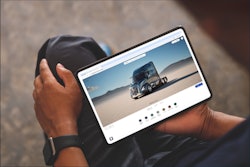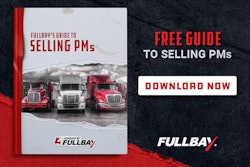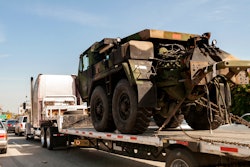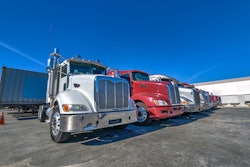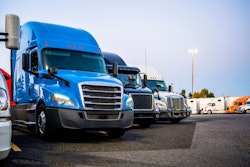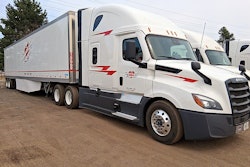A driver for Summitt Trucking stops at a Flying J location, walks up to a Scan & Go kiosk, swipes his TCH fuel card and follows the prompts.
The first screen shows all the loads he has delivered but still has outstanding paperwork he needs to scan. He selects the load(s) he will scan and is taken to another screen where he selects a document type – a bill of lading, trip sheet, etc. He places the document into a sheet-fed scanner and repeats the process for remaining documents.
“It is just like going to an ATM machine,” says Dan McKinnon, network administrator for Summitt Trucking, a 400-truck carrier based in Clarksville, Ind.
Before Summitt Trucking used Scan & Go, drivers completed cover sheets and handed their paperwork over the counter to clerks at truck stops to scan. And when the images arrived at Summitt Trucking, a billing clerk still had to index them.
“You had to touch paperwork twice,” he says. “By going this route, (drivers) are doing the indexing for us.”
Today, images captured by Scan & Go are routed directly into Summitt Trucking’s billing system. A billing clerk can immediately complete the invoices and print supporting documents.
To sharpen the edge of its remote scanning solution, Summitt Trucking uses a monitoring tool called Watchdog from enterprise software provider TMW Systems. Driver managers receive e-mail alerts on drivers that have not scanned their paperwork within 24 hours of delivering a load. Since deploying these technologies, Summitt Trucking has reduced its billing lag time from 10 days to less than 1.5 days, McKinnon says.
To further reduce billing lag, the company is considering in-cab scanning. “It is a huge hardware investment, but sooner or later, that will be the ‘end all,’ ” McKinnon says. “The truck cab is going to be an office.”
Today, fleets are able to leverage a variety of scanning solutions at truck stops, third-party outsource services and inside the cab. In reality, any computer with an Internet connection can be a remote scanning station.
About 10 years ago, Pegasus TransTech launched its first remote scanning solution – Field Imaging – that scanned, indexed and forwarded documents to a central server. Shortly thereafter, the company launched e-Scan and other Internet-based software solutions. In June 2002, it created the first truck stop scanning network called Transflo Express that has grown to include about 500 truck stops, says Bob Helms, chairman of Pegasus TransTech.
Documents from the cab
Recently, Pegasus TransTech launched Transflo Now to enable in-cab scanning. Available as a free download for laptop computers and onboard computers with mobile communication systems, Transflo Now lets drivers scan documents into the same data center configuration as Transflo Express. Depending on fleet preferences, drivers can just hit scan, as well as send or index their documents.
“We are trying to make ‘anywhere anytime’ scanning possible for the driver,” Helms says. Pegasus TransTech has not officially announced a relationship with any mobile communications providers for Transflo Now, but it has commitments from fleets that plan to use the software in thousands of mobile devices, Helms says.
“Trucking companies are very interested in deploying technology when it is cost-effective,” he says.
Other in-cab scanning solutions include recent introductions from Microdea and ACS TripPak Services. In September, onboard computing and communications provider PeopleNet announced a new offering, In-Cab Scanning, through a partnership with Microdea, a document imaging and workflow management software vendor.
In October, ACS TripPak Services announced InCab Scanning through an agreement with DriverTech. The DriverTech TruckPC onboard computing platform uses satellite, cellular and Wi-Fi communications and a Windows XP operating system – important features that enable it to work with a variety of mobile scanners and printers, the company says.
“InCab Scanning provides drivers yet another option to advance their paperwork so that it can be processed quickly and efficiently,” says Kelly Walkup, vice president and general manager of ACS Expedited Solutions, providers of TripPak Services.
ACS TripPak Services also offers a range of outsourcing options and integrated solutions for managing documents. Carriers, depending on their needs and driver preferences, can use a combination of truck stop scanning, TripPak Express drop boxes, delivery of paper documents to TripPak for scanning, and now in-cab scanning.
If there is a downside to in-cab scanning, it is the added cost and time required to support mobile scan devices. By comparison, adding an extra scan station at a terminal requires little investment.
“Our imaging solution has no extra licenses for extra scanning sites,” says Paul Bort, systems engineer for TMW Systems. Fleets can have a clerk do the scanning at a terminal, or set up a kiosk and have drivers scan and index their own documents. Truck stop scanning solutions from Flying J, Pegasus TransTech and ACS TripPak Services also integrate easily into TMW’s imaging application, he says.
For in-cab scanning, one TMW customer requires its owner-operators to have laptops, Bort says. By plugging a scanner into the USB port, the company’s drivers use a simple off-the-shelf software application to e-mail images directly to the fleet’s TMW Imaging application, he says.
Greater productivity
On the back end of the process, document management vendors are making their offerings more powerful and easier to use. The latest capabilities of McLeod’s Document Imaging system include an Automated Forms Recognition module that automatically captures data on forms and indexes documents by determining the document type. As a result, paperwork can be processed without the need for manual coding and input by clerks or drivers when using truck stop or in-cab scanning, the company says.
The Automated Forms Recognition module consists of four different engines that manage and control document flow: a bar code engine, OMR (optical mark recognition), a data validation engine that ensures accuracy of index information against the operations database, and a forms recognition engine that uses OCR (optical character recognition) and topography technology to classify documents.
Fleets also are using remote scanning to stay on top of safety and compliance. Today, Rair Technologies receives about 50 percent of the millions of documents it processes for carriers each month – driver files and driver logbooks – electronically, says Steve Wilhelm, senior vice president of marketing and business development.
Every 15 minutes, Rair imports the scanned images that arrive on its FTP site from a variety of sources, such as truck stop scanning and carrier locations. Using its proprietary software, Rair converts the images to TIF images. It then uses OCR software to process handwritten driver logbooks into electronic files and detect all inaccuracies.
Besides automating safety and compliance audits, Rair provides disaster-proof data storage.
“That is part of the benefit that you get with imaging your documents,” Wilhelm says. “If you need to retrieve a document, you can do that right online.”
Someday you might be able to go completely paperless. Until then, a variety of remote scanning technologies and services are available to efficiently handle the many exceptions as you make the transition.


